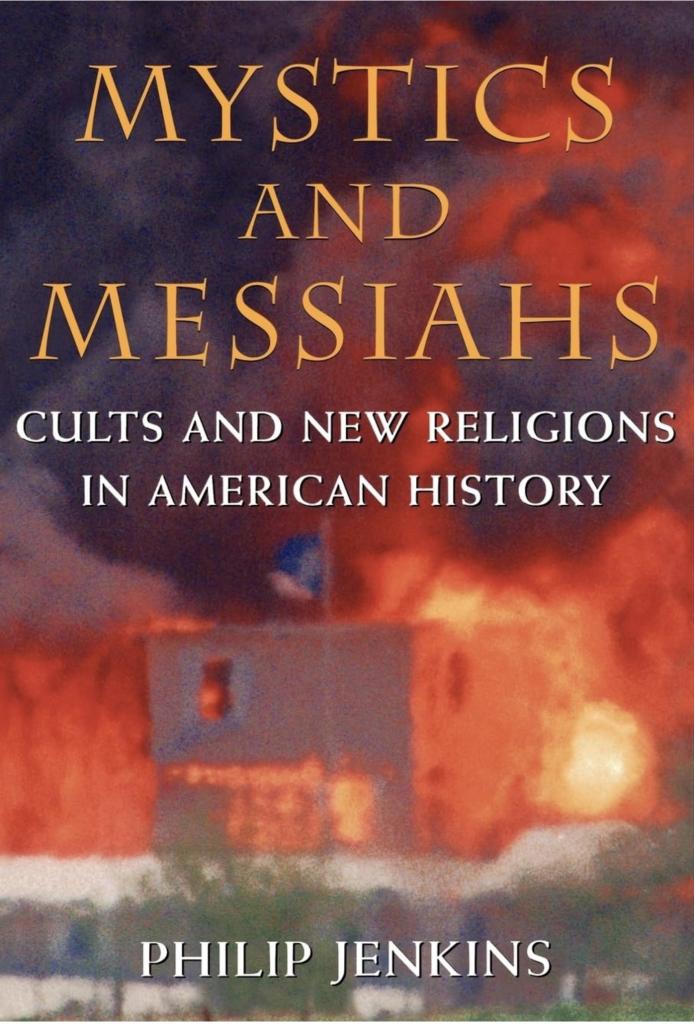I have been writing about my writing, or rather about the topics on which I have researched and published through the centuries. Today’s topic, the Satanism Scare.
In the 1980s, the issue of child sexual abuse attracted enormous public attention, and themes of trauma and recovery generated a whole publishing industry. One of the most popular and influential recovery texts, The Courage to Heal (1988) includes the story of a woman who claimed that she had as a child been the victim of a cult led by the “town leaders, business-people and church officials” of “an upper middle class town in the Midwest” in the mid- or late- 1930s. The woman described being “abused in rituals that included sexual abuse, torture, murder, photography and systematic brainwashing through drugs and electric shock.” By the age of twelve, she was a “breeder,” bearing children for the cult to sacrifice. Another older survivor reported “near total involvement of the entire village where she grew up on the affluent North Side of Chicago, Illinois, during the 1930s. Her parents … as well as Christian ministers, policemen, lawyers and socialites were involved” in a cult active in human sacrifice and Black Masses. The book treats such stories quite unsceptically.
In retrospect, such tales obviously look absurd, and they illustrate the lunatic charges that were circulating during the Satanism Scare of these years. Satanic stories appeared very frequently in mainstream media outlets, and in books from major publishers (Courage to Heal came out from Harper and Row). I don’t want to say too much about the origins and development of that scare here, except to remark how astonishing it is that the whole affair has dropped so thoroughly out of the public memory of the era. Yes, Virginia, the United States in the late twentieth century really did have a full scale witchcraft panic. Here I will describe how encountering those ideas played out in my own research and writing through the years, creating a very long arc that is, oddly, still in progress.
Very briefly, the panic originated with the deeply flawed investigation of sexual abuse allegations at the McMartin preschool in Manhattan Beach. Therapists reported that very young child “victims” (note my quotes) were recounting all sorts of bizarre manifestations, including the killing of animals. At an early stage of the proceedings, investigators not only believed those charges in every insane detail, but they interpreted them as evidence of a Satanic group involved in something called Ritual Child Abuse, or Satanic Ritual Abuse, SRA. Those ideas had a national impact on prosecutors, police, and therapists, and they inspired many copycat cases over the next decade, roughly 1984-1995.
The Satanic Panic was in full flood. In 1988, a work targeted at law-enforcement professionals linked Satanists to
the murders of unbaptized infants, child sexual abuse in day-care, rape, ritual abuse of children, drug trafficking, arson, pornography, kidnapping, vandalism, church desecration, corpse theft, sexual trafficking of children and the heinous mutilation, dismemberment and sacrifices of humans and animals… [They are] responsible for the deaths of more than 60,000 Americans each year, including missing and runaway youth.
That then fed into the recovered memory fad of the era. As therapists interviewed adults, they claimed to recover alarming childhood experiences involving pentacles, circles, and/or chanting, suggesting a Satanic context. According to the theories of the time, patients concealed those hideous traumas by forming a protective psychic shield in the form of alternate personalities. This was the golden age of Multiple Personality Disorder. Often, the therapists were sincere if misguided in their efforts, which in practice had the effect of instilling such memories and traumas where none had existed before. In some cases, they weren’t so well intentioned. The best way to acquire a diagnose of Multiple Personality in those years was to have a generously funded medical insurance package with ample provision for long term commitment. By the mid-1990s, recovered memory claims were facing stiff criticism, and SRA cases were collapsing.
There is a nice potted history of this whole affair in the recent obituary of Dr Bennett Braun, a principal actor in the saga. As the New York Times noted, “He diagnosed dozens of patients with what he said were suppressed memories of being tortured by cults. He later lost his license.” Among many striking sentences in the story, I do like this one, from one of his patients: “I began to add a few things up and realized there was no way I could come from a little town in Iowa, be eating 2,000 people a year, and nobody said anything about it.” Well, yeah. Minnesota maybe, but not Iowa.
This set off all sorts of interesting issues for me as a researcher. I was publishing a lot against the Satanic scare at an early date, from 1985 onward. I knew it was garbage, and said so, particularly focusing on writing for professional publications directed at law enforcement – somebody had to counteract the nonsense they were receiving through the regular media, and from the endless seminars they were being offered so enthusiastically. For a while, I was contemplating a major book on the whole farrago, but that scheme came to nothing when I saw the wonderful book by Debbie Nathan and Michael Snedeker, Satan’s Silence: Ritual Abuse and the Making of a Modern American Witch Hunt (Basic Books, 1995). What else was left to say?
But in fact, there were lots of other angles to pursue. Let’s go back to the specific claims that were surfacing in those fraught years, claims of the kind I noted earlier. Imagine a patient who was a boomer woman (and overwhelmingly, we are dealing with women), born, say, in 1946. She describes the horrors supposedly inflicted on her by evil cults, which must have occurred when she was six or seven, so in the early 1950s. The pioneering text of the recovered Satanic memory movement was Michelle Remembers (1980), which describes a deadly cult supposedly operating in Vancouver in the late 1950s.
Incidentally, one very common idea in that era was that of multi-generational or hereditary Satanic cults, who had presumably been doing their evil deeds generation after generation, back to Salem and beyond, initiating each new generation from their earliest childhood. You may know that term “Hereditary” as Ari Aster borrowed it as the title for his terrific 2018 horror film.
But there was a great question here. Intuitively, the charges were ridiculous, and radically counter-intuitive. I for one do not recall Satanic cults and the Black Mass as recurring themes of Leave it to Beaver. But just what was the evidence for really lethal cults in the that era? And specifically, what about charges of human sacrifice? Was I able to say that those cults had not existed in mid-twentieth century North America? How did I know that ? How could I really say that “Hereditary” cults had not existed? How could I prove a negative?
That set me off on a long term research project which is still not wholly completed. I started delving into any and all accounts I could find of cults and fringe religions in American history, whether in newspapers and magazines, in fictional accounts or films. I deliberately looked for the worst and most hysterical charges that people could produce, and these were very abundant. “Cult Scares” in general are a very well established American reality. But even though the literature on such groups is immense, absolutely nothing whatever corresponds to the claims emerging in recovered memory. SRA was an invention of the mid-1980s, and all those “memories” were bogus back projections. Put another way, SRA was as Eighties as Cyndi Lauper.
In passing, I will note that this research had the odd fun moment. At one stage, I made contact with the head of a Satanic church that was wholly legal and above ground. My kids were delighted whenever I received mail from our very own Satanic High Priest, as he always used Garfield stickers on his envelopes. He just seemed so nice.
That research then took me to preparing a sizable book proposal on the whole mythology of cults and human sacrifice in American history, which I tentatively titled To What Green Altar? This comes from Keats’s Ode on a Grecian Urn:
Who are these coming to the sacrifice?
To what green altar, O mysterious priest,
Lead’st thou that heifer lowing at the skies,
And all her silken flanks with garlands drest?
I liked the idea of the “mysterious priest.” As it turned out, the book did not happen in exactly that form but it evolved into my 2000 book Mystics and Messiahs, a much more substantial and wide-ranging history of cults and fringe religions. Part of the material also became a major section of my 1998 book Moral Panic, about the history of child abuse and molestation. This included a sizable chapter on “The Road to Hell: Ritual Abuse and Recovered Memory.”
That took me as far as I could go in one direction, but the topic still promised new things. The more I dug into those claims about Satanic cults in small American towns, the more I actually found them – but in the form of horror fiction, of pulp fiction, of scary novels, especially from the years between around 1920 and 1950. I published on these matters, on horror novels of the 1920s like The Place Called Dagon.
This was in fact a whole American component of the very large transnational cultural phenomenon that today we call Folk Horror. As I define that term, this is
the idea that potent ancient forces and deep-rooted evils survive in the landscape, scarcely acknowledged by the modern world. In isolated communities, active witches or pagan groups mobilize those dark forces, deploying rituals dating from pre-Christian times. The plots involved clashes between those primordial world views and the representatives of a more rational modernity. Innocent outsiders can be entrapped in these fearsome proceedings, with potentially lethal consequences. The genre thus relies on confrontations with an unsuspected ancient reality, which is inconceivably perilous.
Does that sound familiar from the SRA and recovered memory era? The difference of course is that the modern horror genre is just that, it is totally and explicitly fictional. Think of The Wicker Man.
All of which brings me to the book project that I am working on right now, which is entitled Witches In The Village: Recovering The First Century Of Folk Horror 1870-1970. And yes, I do indeed have a section in that with the subtitle To What Green Altar? It was too good to waste.
And now, it is the title of a blog post.
As a footnote here: I am a big fan of horror author Grady Hendrix, author of, among many other titles, Horrorstör and The Southern Book Club’s Guide to Slaying Vampires. Hendrix obviously grew up as a teen during the scariest of the Satanism Scare, and that latter book precisely catches the mood of that late 1980s setting, with plenty of shrewd observations about conspiracy theories and social panics, together with a lot of humor. Also very good is his Paperbacks from Hell: The Twisted History of ’70s and ’80s Horror Fiction. This includes the classic observation about the author of Michelle Remembers: “Could the demonic ordeal described by Michelle Smith possibly be real? Spoiler alert: No.”
Finally, as a warning, when you have read Horrorstör, you will never view IKEA in the same light again.














